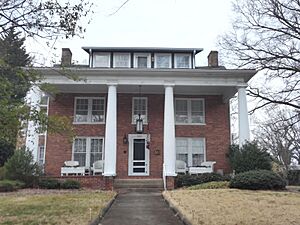College Hill, Greensboro, North Carolina facts for kids
Quick facts for kids |
|
|
College Hill Historic District
|
|

Typical nineteenth-century residence in College Hill
|
|
| Location | Roughly bounded by W. Market St., S. Cedar St., Oakland Ave. and McIver St., Greensboro, North Carolina |
|---|---|
| Area | 72 acres (29 ha) |
| Built | 1837 |
| Architect | Epps, Orlo; Barton, Harry |
| Architectural style | Bungalow/craftsman, Queen Anne, Colonial Revival |
| MPS | Greensboro MPS |
| NRHP reference No. | 93001191 |
| Added to NRHP | November 4, 1993 |
College Hill is a historic neighborhood in the city of Greensboro, North Carolina. It was the very first neighborhood established in Greensboro. This area is known for its beautiful old homes and its close ties to nearby colleges.
Contents
Geography
Where is College Hill?
The College Hill neighborhood is located in the west-central part of Greensboro. It has clear boundaries:
- To the north, it's bordered by West Market Street.
- To the west, you'll find McIver and Tate streets.
- The Southern Railway tracks mark its southern edge.
- To the east, it's bordered by Freeman Mill Road, Spring Street, West McGee Street, and Greensboro College.
College Hill Historic District
Inside the larger College Hill neighborhood is a smaller area called the College Hill Historic District. This district has slightly different borders than the neighborhood itself. Because of this, some important historic buildings, like Wafco Mill and the Greensboro College administration building, are part of the city's historic district but not the National Register District. Both of these buildings are listed separately on the Historic Register.
What is the ZIP Code?
The 27403 ZIP code covers College Hill. It also includes other neighborhoods like Glenwood, Lindley Park, and Sunset Hills.
History
This area, located on a hilltop west of downtown Greensboro, was settled in the 1840s and 1850s. Many of the first residents were connected to the nearby Greensboro College. Because many early settlers were Methodists, the hill was nicknamed "Piety Hill" in the 1800s. Some large, comfortable homes from that time are still standing, such as the Bumpass-Troy House.
The hill's convenient location made it a popular choice for Greensboro's middle class during the Victorian era. People wanted to escape the busy downtown area. After the University of North Carolina at Greensboro (UNCG) was founded in 1891, the area was renamed "College Hill." In the 1890s, many fancy Queen Anne-style houses were built along streets like Walker Avenue and Mendenhall Street. The Orlo Epps House, built in 1890, was designed by Orlo Epps. He was also the architect for UNCG's Julius I. Foust Hall. His house featured detailed porch posts, shingle siding, and colorful paint.
Development in College Hill wasn't just for homes. Greensboro's oldest fire station is at 547 South Mendenhall Street. This two-story brick building served as the West End Hose Company from 1897 to 1919. It was replaced by a new building nearby. Both old fire stations have been repurposed; one is now a general store, and the other is a private home. The Wafco Mill complex started as a grist mill in 1893. It was later restored in 1983 and turned into apartments.
College Hill also has two small shopping areas. The intersection of Tate Street and Walker Avenue has many restaurants, coffee shops, and stores. These places often serve students from the nearby university. Another smaller collection of stores is at Mendenhall and Spring Garden streets. The many students and growing college campuses bring a lot of energy to the neighborhood. However, they also create challenges, like finding enough parking on the narrow streets.
Parks and Public Spaces
- Peabody Park (on UNCG campus)
- Springdale Park
Notable Architects and Builders
- Harry Barton
- Orlo Epps
- Frank A. Weston
College Hill Neighborhood Association
The College Hill Residents Association was started in July 1978. It became a non-profit organization. In December of that year, its name changed to the College Hill Neighborhood Association. Anyone who lives in the neighborhood or owns property there can become a member.
Other Notable Civic Institutions
- College Place United Methodist Church
- Greensboro College
- Greensboro Primitive Baptist Church
- Presbyterian Church of the Covenant
- The University of North Carolina at Greensboro (UNCG)
On the National Register of Historic Places
The College Hill Historic District is a special area listed on the National Register of Historic Places. This means it's recognized for its important history and architecture. The district includes 320 contributing buildings and one contributing site. Most of these buildings are homes built between the 1890s and 1930s. They show off different architectural styles like Queen Anne, Colonial Revival, and Bungalow / American Craftsman styles.
The oldest house in the district is the Walker-Scarborough House, built around 1845. It's believed that Governor John Motley Morehead built it for his daughter, Letitia, when she married Stephen Walker. The Bumpas-Troy House, built in 1847, is also in the district and is listed separately. Other important buildings include the Orlo Epps House, the West End Hose Company Firehouse, and the Presbyterian Church of the Covenant.
The College Hill Historic District was officially added to the National Register of Historic Places in 1993.




